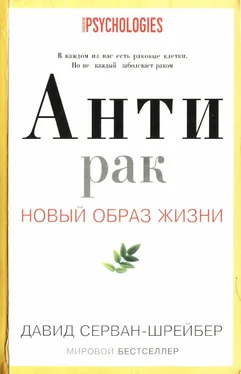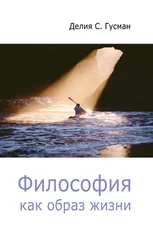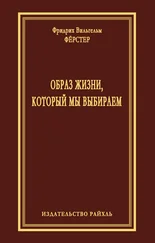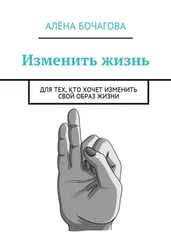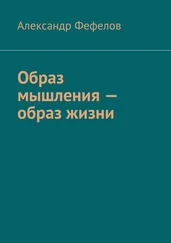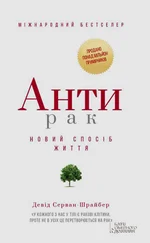Давид Серван-Шрейбер - Антирак. Новый образ жизни
Здесь есть возможность читать онлайн «Давид Серван-Шрейбер - Антирак. Новый образ жизни» — ознакомительный отрывок электронной книги совершенно бесплатно, а после прочтения отрывка купить полную версию. В некоторых случаях можно слушать аудио, скачать через торрент в формате fb2 и присутствует краткое содержание. Город: Москва, Год выпуска: 2010, ISBN: 2010, Издательство: РИПОЛ классик, Жанр: sci_medicine_alternative, Психология, на русском языке. Описание произведения, (предисловие) а так же отзывы посетителей доступны на портале библиотеки ЛибКат.
- Название:Антирак. Новый образ жизни
- Автор:
- Издательство:РИПОЛ классик
- Жанр:
- Год:2010
- Город:Москва
- ISBN:978-5-386-02111-5
- Рейтинг книги:4.26 / 5. Голосов: 34
-
Избранное:Добавить в избранное
- Отзывы:
-
Ваша оценка:
- 80
- 1
- 2
- 3
- 4
- 5
Антирак. Новый образ жизни: краткое содержание, описание и аннотация
Предлагаем к чтению аннотацию, описание, краткое содержание или предисловие (зависит от того, что написал сам автор книги «Антирак. Новый образ жизни»). Если вы не нашли необходимую информацию о книге — напишите в комментариях, мы постараемся отыскать её.
Антирак. Новый образ жизни — читать онлайн ознакомительный отрывок
Ниже представлен текст книги, разбитый по страницам. Система сохранения места последней прочитанной страницы, позволяет с удобством читать онлайн бесплатно книгу «Антирак. Новый образ жизни», без необходимости каждый раз заново искать на чём Вы остановились. Поставьте закладку, и сможете в любой момент перейти на страницу, на которой закончили чтение.
Интервал:
Закладка:
101. Kouba, M., “Quality of Organic Animal Products,” Lifestock Production Science 80 (2003): 33-40.
102. Agence Française de Sécurité Sanitaire des Aliments, Avis de l’agence française de de sécurité sanitaire . . .
103. Kouba, “Quality of Organic Animal Products.”
104. Observatoire des Résidus et Pesticides (2006). (Accessed at http://www.observatoire-pesticides.gouv.fr/index.php?pageid=381.)
105. Ibid.
106. Hayes, T., K. Haston, M. Tsui, et al., “Herbicides: Feminization of Male Frogs in the Wild,” Nature 419, no. 6910 (2002): 895-96.
107. Hayes, T. B., A. Collins, M. Lee, et al., “Hermaphroditic, Demasculinized Frogs After Exposure to the Herbicide Atrazine at Low Ecologically Relevant Doses,” Proceedings of the National Academy of Sciences of the United States of America 99, no. 8 (2002): 5476-80.
108. Batistatou, A., D. Stefanou, A. Goussia, et al., “Estrogen Receptor Beta (ERbeta) Is Expressed in Brain Astrocytic Tumors and Declines with Dedifferentiation of the Neoplasm,” Journal of Cancer Research & Clinical Oncology 130, no. 7 (2004): 405-10.
109. Provost, D., A. Gruber, P. Lebailly, et al., “Brain Tumors and Exposure to Pesticides: A Case-Control Study in Southwestern France,” Occupational and Environmental Medicine 2007.
110. Curl, C. L., R. A. Fenske, and K. Elgethun, “Organophosphorus Pesticide Exposure of Urban and Suburban Preschool Children with Organic and Conventional Diets,” Environmental Health Perspectives 111, no. 3 (2003): 377-82.
111. Pesticide Action Network North America, “Chemical Trespass: Pesticides in Our Bodies and Corporate Accountability” (Pesticide Action Network of North America, 2004).
112. Aubert, C., Présence de pesticides dans le lait maternel avec ou sans alimentation biologique. In. Paris; 1986.
113. Lu, C., K. Toepel, R. Irish, et al., “Organic Diets Significantly Lower Children’s Dietary Exposure to Organophosphorus Pesticides,” Environmental Health Perspectives 114, no. 2 (2006): 260-63.
114. Doll, R., and R. Peto, “The Causes of Cancer: Quantitative Estimates of Avoidable Risks of Cancer in the United States Today,” Journal of the National Cancer Institute 66, no. 6 (1981): 1191-1308.
115. Wynder, E. L., and E. A. Graham, “Tobacco Smoking as a Possible Etiological Factor in Bronchogienic Carcinoma,” JAMA 143 (1950): 329-36.
116. Sasco, A. J., M. B. Secretan, and K. Straif, “Tobacco Smoking and Cancer: A Brief Review of Recent Epidemiological Evidence,” Lung Cancer 45 Supp. 2 (2004): S3-9.
117. Bach, P. B., et al., “Variations in Lung Cancer Risk Among Smokers,” Journal of the National Cancer Institute 95 (2003): 470-78.
118. Pimentel, D., Techniques for Reducing Pesticide Use: Economic and Environmental Benefits (Chichester, UK: John Wiley & Sons, 1997).
119. Cardis, Elizabeth, interview, France Evening News , June 15, 2008.
120. Hardell, L., M. Carlberg, and K. Mild, “Case-Control Study of the Association Between the Use of Cellular and Cordless Telephones and Malignant Brain Tumors Diagnosed During 2000-2003,” Environmental Research 100 (2006): 232-41.
121. U.S. Department of Health and Human Services, The Health Consequences of Smoking: A Report of the Surgeon General (Atlanta, GA: U.S. Department of Health and Human Services, Centers for Disease Control and Prevention, National Center for Chronic Disease Prevention and Health Promotion Office on Smoking and Health, 2004).
122. Travis, L., et al., “Cancer Survivorship—Genetic Susceptibility and Second Primary Cancers: Research Strategies and Recommendations,” Journal of the National Cancer Institute 98, no. 1 (2006): 15-25.
123. Dupont, G., “L’élevage Contribue Beaucoup au Réchauffement Climatique,” Le Monde , December 5, 2006, sec. 9.
124. Bittman, M., “Rethinking the Meat-Guzzler,” New York Times, January 27, 2008.
125. Environmental Working Group, “The Full List: 43 Fruits and Veggies,” available at www.ewg.org, accessed 2006.
Глава 7
1. Baclesse, F., A. Ennuyer, and J. Cheguillaume, “May a Simple Tumorectomy Followed by Radiotherapy Be Performed in the Case of Mammary Tumor?” Journal de Radiologie, d’Electrologie, et de Medecine Nucleaire 41 (1960): 137-9.
2. Fisher, B., et al., “Twenty-Year Follow-up of a Randomized Trial Comparing Total Mastectomy, Lumpectomy, and Lumpectomy Plus Irradiation for the Treatment of Invasive Breast Cancer,” New England Journal of Medicine 347, no. 16 (2002): 1233-41.
Глава 8
1. Cao, Y., and R. Cao, “Angiogenesis Inhibited by Drinking Tea,” Nature 398, no. 6726 (1999): 381.
2. Béliveau, R., and D. Gingras, Les aliments contre le cancer (Outremont, Canada: Trécarré, 2005).
3. Béliveau, R., and D. Gingras, Foods That Fight Cancer: Preventing Cancer Through Diet (New York: Random House, 2006).
4. Campbell, T. C., and T. M. Campbell, Le Rapport Campbell: La plus vaste étude internationale à ce jour sur la nutrition par Colin Campbell, Thomas M Campbell, et Annie Ollivier (Outremont, Canada: Editions Ariane, 2008).
5. Campbell, T. C., The China Study (Dallas, TX: BenBella Books, 2005).
6. Fidler, I. J., “Angiogenic Heterogeneity: Regulation of Neoplastic Angiogenesis by the Organ Microenvironment,” Journal of the National Cancer Institute 93, no. 14 (2001): 1040-41.
7. Fidler, I. J., “Critical Factors in the Biology of Human Cancer Metastasis: Twenty-Eighth G. H. A. Clowes Memorial Award Lecture,” Cancer Research 50, no. 19 (1990): 6130-38.
8. Paget, S., “The Distribution of Secondary Growths in Cancer of the Breast,” Lancet 1 (1889): 571-3.
9. Coussens, L. M., Z. Werb, L. M. Coussens, et al., “Inflammation and Cancer,” Nature 420, no. 6917 (2002): 860-67.
10. Jankun, J., S. H. Selman, R. Swiercz, et al., “Why Drinking Green Tea Could Prevent Cancer,” Nature 387, no. 6633 (1997): 561.
11. Cao and Cao, “Angiogenesis Inhibited by Drinking Tea.”
12. Demeule, M., B. Annabi, J. Michaud-Levesque, et al., “Dietary Prevention of Cancer: Anticancer and Antiangiogenic Properties of Green Tea Polyphenols,” Medicinal Chemistry Reviews-Online 2 (2005): 49-58.
13. Ibid.
14. Zhou J.-R., L. Yu, Z. Mai, G. L. Blackburn, “Combined Inhibition of Estrogen-Dependent Human Breast Carcinoma by Soy and Tea Bioactive Components in Mice,” International Journal of Cancer , 2004; 108(1): 8-14.
15. Zhou, J-R., L. Yu, Y. Zhong, et al., “Soy Phytochemicals and Tea Bioactive Components Synergistically Inhibit Androgen-Sensitive Human Prostate Tumors in Mice,” Journal of Nutrition 133, no. 2 (2003): 516-21.
16. Inoue, M., et al., “Regular Consumption of Green Tea and the Risk of Breast Cancer Recurrence: Follow-up Study from the Hospital-Based Epidemiologic Research Program at Aichi Cancer Center (HERPACC), Japan,” Cancer Letters 167, no. 2 (2001): 175-82.
17. Kurahashi, N., et al., “Green Tea Consumption and Prostate Cancer Risk in Japanese Men: A Prospective Study,” American Journal of Epidemiology 167, no. 1 (2007): 71-77.
18. Knoops, K. T. B., et al., “Mediterranean Diet, Lifestyle Factors, and 10-Year Mortality in Elderly European Men and Women—The HALE Project,” JAMA 292 (2004): 1433-39.
19. Oldways Trust Mediterranean Diet Foundation US, “Mediterranean Diet: The Scientific Evidence” (2009). (Accessed March 15, 2009, at http://www.oldwayspt.org/.)
Читать дальшеИнтервал:
Закладка:
Похожие книги на «Антирак. Новый образ жизни»
Представляем Вашему вниманию похожие книги на «Антирак. Новый образ жизни» списком для выбора. Мы отобрали схожую по названию и смыслу литературу в надежде предоставить читателям больше вариантов отыскать новые, интересные, ещё непрочитанные произведения.
Обсуждение, отзывы о книге «Антирак. Новый образ жизни» и просто собственные мнения читателей. Оставьте ваши комментарии, напишите, что Вы думаете о произведении, его смысле или главных героях. Укажите что конкретно понравилось, а что нет, и почему Вы так считаете.
